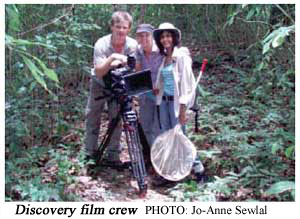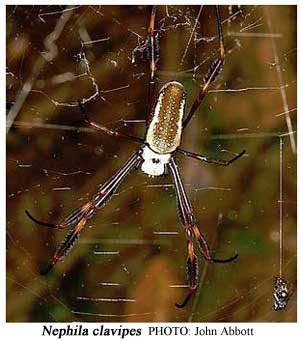 |
 |
 |
|
May 2012
|
Spiders carry out many useful ecological functions, for instance they are pollinators. The spiders doing this job include those belonging to the spider family Thomisidae commonly referred to as “crab spiders” which act as pollinators of plants, as they move from flower to flower hiding between the petals to ambush insect prey. The ability of spiders to regulate insect populations coupled with the fact that they are quite voracious carnivores allows them to perform another important ecosystem service, that of biological control agent. This service assists the agricultural sector in protecting crops against pests. Simply put, they are more interested in eating the insects that prey on the crops than the crops themselves. Only a small percentage of spider species supplement their diet with other substances like nectar.
All spiders produce silk, however not all species build webs, which are primarily used as a prey capture device. Some spiders use silk to construct retreats to rest in, to wrap egg sacs or for transport (ballooning). This method of transport is mainly used by very young spiders to escape their cannibalistic siblings or by others to get to more suitable habitats. Usually, the spider releases a length of silk from a height such as from a rock or a leaf and if it catches on the wind, it carries the spider along with it. Spider silk is quite strong and the remnants of the webs of some species like Nephila clavipes (Golden Orb Weaver) which is found right here in Trinidad and Tobago can persist for months after it has been abandoned by the spider. Some tribes in the South Pacific use the silk from a relative of this species to catch fish. It is the strength and beauty of silk that makes it very applicable to a variety of industries for example in textiles. However, it is also applicable to the security and military industries as the silk of some species is ten times tougher than Kevlar, the material used to make bulletproof vests.
Jo-Anne Nina Sewlal, BSc, MPhil, FLS, AMSB, is attached to the Department of Life Sciences, UWI, St. Augustine. A version of this article originally appeared in the March edition of Earth Conscious magazine at www.earthconsciousmagazine.com |


 Early last year I was approached by a UK production company about appearing in an episode of the documentary series, “Wild Freaks of Nature” for the Discovery Channel which focused on the importance of spider silk. But this is just one aspect of spiders that make them fascinating creatures to study. People tend to cringe at the mention of their name and think they belong in horror movies, but these arthropods play very important roles in our ecosystems.
Early last year I was approached by a UK production company about appearing in an episode of the documentary series, “Wild Freaks of Nature” for the Discovery Channel which focused on the importance of spider silk. But this is just one aspect of spiders that make them fascinating creatures to study. People tend to cringe at the mention of their name and think they belong in horror movies, but these arthropods play very important roles in our ecosystems.  Spiders also act as biological indicators as the presence or absence of certain species can be used to indicate the health of ecosystems. This is linked to the mid-level position they occupy in food webs, where they act as predators of organisms at lower trophic levels while acting as prey for organisms in higher trophic levels like lizards and birds. Their presence and the species found in a habitat depend on the animals found at lower trophic levels.
Spiders also act as biological indicators as the presence or absence of certain species can be used to indicate the health of ecosystems. This is linked to the mid-level position they occupy in food webs, where they act as predators of organisms at lower trophic levels while acting as prey for organisms in higher trophic levels like lizards and birds. Their presence and the species found in a habitat depend on the animals found at lower trophic levels.  Trinidad and Tobago contain 52 of the 110 spider families recorded in the world. It is also quite a unique location to study biodiversity, because they are continental islands—they broke away from the South American continent taking flora and fauna with them. Also, the many millennia of isolation from the mainland have resulted in the development of endemic species, thus adding to the uniqueness of this country’s biodiversity.
Trinidad and Tobago contain 52 of the 110 spider families recorded in the world. It is also quite a unique location to study biodiversity, because they are continental islands—they broke away from the South American continent taking flora and fauna with them. Also, the many millennia of isolation from the mainland have resulted in the development of endemic species, thus adding to the uniqueness of this country’s biodiversity.